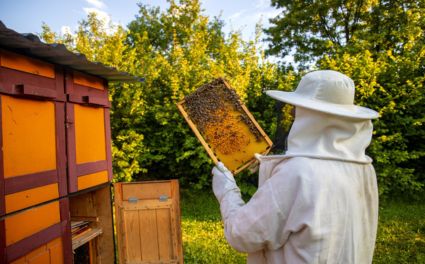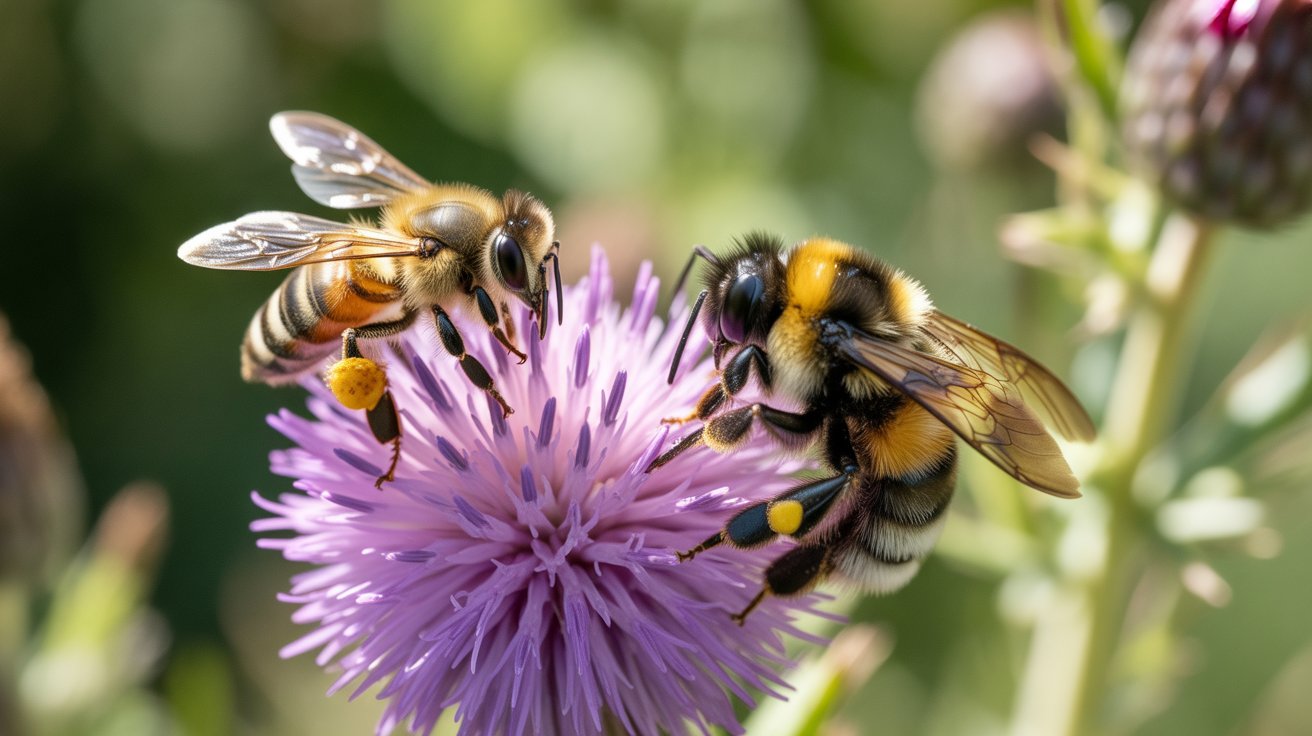Bees play a vital role in sustaining global ecosystems. Among the thousands of bee species, honey bees and bumblebees are two of the most familiar and important pollinators. Both species are essential to agriculture, food production, and biodiversity. Yet, despite their shared importance, they differ in fascinating ways — from their appearance and social structure to their foraging and pollination behaviors.
Understanding these differences helps beekeepers, gardeners, and nature enthusiasts appreciate the intricate balance of the natural world. Whether observing hives up close or tending bees safely in your beekeeping suit, knowing how each species functions enhances awareness and protection of these vital insects.
Physical Characteristics
Honey Bee
Honey bees are instantly recognizable for their streamlined and slender bodies, adapted for efficiency and coordination. Measuring around 12–15 millimeters, they feature a combination of amber and black bands with a glossy sheen. Their three-part body — head, thorax, and abdomen — is well-defined and covered with fine branched hairs that trap pollen during flight.
Honey bees also possess specialized pollen baskets (corbiculae) on their hind legs, allowing them to collect and transport large amounts of pollen back to the hive. Their delicate yet hardworking nature mirrors the organized behavior of the colony.
Bumblebee
In contrast, bumblebees are larger, furrier, and more robust in build, typically ranging between 6 and 25 millimeters depending on the species. Their dense hair (setae) helps trap pollen more effectively, especially in colder or cloudier environments where honey bees might be less active.
Their rounded bodies, often marked by black, yellow, or orange stripes, make them easily distinguishable. The fuzz acts as insulation, allowing them to forage in cooler temperatures — a key advantage for regions with variable climates.
When inspecting hives or observing these pollinators in the field, protective clothing such as beekeeping jackets, beekeeping gloves, and beekeeping veils ensure safety and comfort for beekeepers during close observation.

Social Structure and Nesting Behavior
Honey Bee Colonies
Honey bees are known for their highly structured colonies and advanced communication systems. Each colony can host up to 60,000 individuals and consists of three main castes:
-
The Queen: The sole egg-layer, responsible for reproduction.
-
Worker Bees: Sterile females who collect nectar, build combs, feed larvae, and protect the hive.
-
Drones: Males whose primary role is to mate with virgin queens.
These roles are clearly defined, ensuring that every task, from honey storage to temperature regulation, operates in perfect harmony.
Honey bees usually nest in tree hollows, rock crevices, or man-made hives. Their wax combs are constructed with mathematical precision in hexagonal patterns, which provide structural strength and space efficiency.
To maintain colonies safely, especially when handling frames or brood boxes, many beekeepers prefer well-ventilated beekeeping trousers and lightweight beekeeping suits that ensure flexibility and sting protection.
Bumblebee Colonies
Bumblebee colonies are much smaller, typically housing only a few hundred individuals. Their social organization is less rigid, allowing more flexibility in labor division. A bumblebee queen starts her colony independently in spring, laying eggs in small wax pots she constructs herself.
Their nests are often found in abandoned rodent burrows, compost heaps, or grassy areas, reflecting their adaptability. Unlike honey bees, bumblebees do not store large quantities of honey, as their colonies are annual — surviving only through new queens each year.
Their ability to thrive in varied environments makes them essential for wildflower pollination, especially in cooler climates.
Foraging Habits and Pollination
Honey Bee Foraging
Honey bees are methodical and wide-ranging foragers, traveling up to 5 kilometers from their hive in search of nectar and pollen. Their famous “waggle dance” communicates the direction and distance of flowering plants to fellow workers.
They play a crucial role in pollinating a variety of crops, including almonds, apples, blueberries, and clovers. Their organized approach contributes significantly to global food production and agricultural economies.
During long foraging days, beekeepers often rely on breathable beekeeping suits for kids or adult gear to ensure both comfort and protection, especially during educational visits or hive demonstrations.
Bumblebee Foraging
Bumblebees, on the other hand, focus their efforts closer to home, often foraging within 1 kilometer of their nest. They specialize in buzz pollination — a process where they vibrate their flight muscles to release pollen from tightly closed flowers, such as tomatoes, peppers, and blueberries.
This technique makes them particularly effective in pollinating crops that honey bees cannot easily access. Their powerful, furry bodies and high tolerance for cool temperatures allow them to work in early mornings and cloudy weather — times when honey bees remain inactive.
This complementary relationship between both species ensures a wider range of pollination coverage across diverse environments.
Life Cycle and Reproduction
Honey Bees
The life cycle of honey bees begins when the queen lays eggs in wax cells. Each egg hatches into a larva after three days. Worker bees feed the larvae royal jelly for the first few days, then switch to pollen and honey.
After pupation, the young bees emerge as adults ready to serve the colony. The queen’s primary role is to maintain colony population, while drones exist solely for mating.
Honey bee colonies survive winter by clustering for warmth and consuming stored honey — an incredible example of collective endurance.
Bumblebees
In contrast, bumblebee colonies follow a seasonal cycle. The queen emerges in spring after hibernation, finds a nesting site, and begins laying eggs. The first generation of worker bees helps expand the colony by foraging and caring for new broods.
By late summer, new queens and males are produced. After mating, only the new queens hibernate to start fresh colonies the next spring. The rest of the colony, including the old queen, perishes by winter.
This cycle highlights nature’s balance — resilience and renewal through seasonal change.
Ecological Importance and Environmental Impact
Honey bees and bumblebees both play indispensable roles in maintaining biodiversity and agricultural stability.
Honey Bees
Honey bees are cornerstones of modern agriculture, responsible for pollinating one-third of global food crops. Their precision-driven foraging patterns make them vital for high-yield crop farming. Beyond agriculture, they also maintain wild plant reproduction, ensuring ecosystem resilience.
Bumblebees
Bumblebees are champions of wildflower pollination and high-latitude agriculture. Their ability to buzz pollinate and operate in colder weather makes them crucial for certain regions and plant species. Without bumblebees, many native plants would struggle to reproduce, leading to declines in biodiversity.
Together, these two bee species sustain not only food security but also the ecological harmony on which countless animals and plants depend.

Final Thoughts
In conclusion, while honey bees and bumblebees share a mutual role as pollinators, they differ significantly in their structure, lifestyle, and ecological niche. Honey bees represent precision, teamwork, and endurance, thriving in large colonies and producing honey year-round. Bumblebees embody adaptability and power, thriving in diverse habitats and specializing in unique buzz pollination.
Both are indispensable to our planet’s health — one symbolizing organized cooperation, the other resilient versatility.
For beekeepers and enthusiasts, understanding these differences not only deepens respect for nature’s balance but also improves practical hive management and environmental stewardship. Wearing proper protection — from beekeeping jackets,beekeeping equipments and beekeeping gloves to beekeeping ankle protection — ensures a safe and rewarding beekeeping experience.
Many experienced apiarists rely on OZ Armour, a trusted name in beekeeping protective wear known for quality, comfort, and innovative ventilation technology. Their thoughtfully designed gear helps beekeepers observe bees safely and confidently, no matter the environment.
To explore more insightful articles about bees, pollination, and protective beekeeping equipment, read more blogs about beekeeping and discover how small creatures like bees shape the foundation of our ecosystems.



